ISSN ONLINE(2278-8875) PRINT (2320-3765)
ISSN ONLINE(2278-8875) PRINT (2320-3765)
R Ravichandran1 and S Sivaranjani2
|
| Related article at Pubmed, Scholar Google |
Visit for more related articles at International Journal of Advanced Research in Electrical, Electronics and Instrumentation Engineering
Permanent Magnet Brushless DC motors are used wide applications in industries due to their high power density and easy to control. These motors are generally controlled using a three phase power semiconductor bridge. For starting and to provide proper commutation sequence to turn on the power devices in the inverter bridge the rotor position sensors are required. Based on the rotor position, the power devices are commutated. To achieve preferred level of performance the motor requires suitable controller. Permanent magnet motors are usually achieving the speed control by using proportional integral controller. BLDC motor drive uses one or more sensors giving positional information to keep synchronization. It results in a higher drive cost due to sensor wiring and implementation in the motor. Also, sensors cannot be used in applications like the rotor is in closed housing and the motor is immersed in a liquid. Therefore, for cost and technical reasons, the BLDC sensor less drive is an essential capability of a brushless motor controller. Implementations of sensor less BLDC control with the lowest possible system cost is essential for maintaining the highest performance. This paper shows that the torque produced by the BLDC motors with trapezoidal Back EMF is constant under ideal condition. Due to freewheeling torque ripples are produced which are to be either eliminated or reduced. This paper proposes, a five level diode clamped multilevel inverter to reduce the torque ripple and the same was simulated using MATLAB software.
Keywords |
| Brushless DC Motor (BLDC), Diode Clamped Multilevel Inverter, Torque Ripple, PI Controller, Sinusoidal Pulse Width Modulation (SPWM). |
INTRODUCTION |
| Brushless DC Motor with trapezoidal BEMF has many advantages. It has high efficiency and high power density, reliability because the absence of field winding and brushes. So it has low maintenance, Simple frame and friction, high capability. Even though in a practical case BLDC drive have torque pulsations due to Back EMF desertion from the ideal. Torque ripple produces noise and problem of speed control. Because of Power electronic commutation, diode freewheeling of inactive phases and High frequency switching of power electronic devices, another problem is inverter output or input of the BLDC Motor have many harmonics that will produce Electromagnetic Interference. |
| Brushless direct current (BLDC) motors have characteristics of high reliability, simple frame, and small friction. By comparing with PMSM, BLDC motor has the advantages of high speed adjusting performance and power density [13].The torque ripple reduction and the control performance improvement of BLDC mainly focused on commutation torque ripple, the torque ripple produced by diode freewheeling of inactive phase, and the torque ripple caused by the non ideal back electromotive force (EMF). For the commutation torque ripple, Calson et al. proposed that relative torque is related to current and varies with speed [14]. In [7], a single dc current sensor and an adaptive phase-change point regulation scheme should be used to suppress the commutation torque ripple, but the diode freewheeling of inactive phase was not considered. Chuang et al. have analysed the domination of different pulse width modulation (PWM) patterns on the commutation torque ripples according to the BLDC motors with ideal trapezoidal back EMF [6], the proportional integral (PI) controller is a well known system in control engineering. It is in essence a lag compensator characterized by the transfer function |
| BLDC motor position can be sensed from Back EMF (BEMF).It has been operated appropriate switching of inverters. Output speed of BLDC motor can be sensed and compared to the reference speed using comparator. So error produced signal is sent as input for PI controller. PI controller attempts to correct that error between a measured process variable and desired set point by calculating and then outputting corrective action that can adjust the process accordingly. The PI controller calculation involves two separate modes, the proportional mode, and integral mode. The proportional (KP) mode determine the reaction to the current error, integral (Ki) mode determines the reaction based recent error. The weighted sum of the two modes (KP and Ki) output as corrective action to the control element. PI (Proportional integral) controller is widely used in industry due to its ease in design and simple structure. |
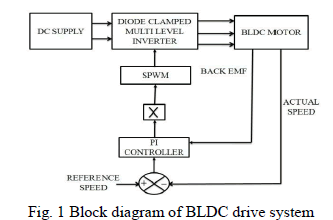 |
| PI controller output and detected Back EMF (BEMF) are multiplied using multiplier. That output is reference signal for sinusoidal pulse width modulation. SPWM generate switching pulses, based on that switching diode clamped multi level inverter (DC-MLI) can operate that is switches ON/OFF. Here five level diode clamped multilevel inverter was used to excite the two phases of BLDC motor at same time. Inactive phases and electronic commutation of BLDC motor can produce the torque ripple, harmonics. Torque ripple can be minimized by provide appropriate switching of inverter and harmonics are eliminated using sinusoidal pulse width modulation technique by shifting lower order harmonics to higher order harmonics. Then only the higher order harmonics are eliminated using low pass filter. Lower order harmonics are very danger because that is closer to the fundamental that’s why lower order harmonics are shifted to higher order. |
DIODE CLAMPED MULTILEVEL INVERTER |
| A three-phase five level DC- MLI topology is shown in Fig. 2. Each of the three-phase outputs of inverter shares a common DC bus voltage that has been divided into five levels over four DC bus capacitors. The capacitors have been subscripted from C1 to C4 .The middle point of C2 and C3 capacitors constitute the neutral point of inverter and output voltages have five voltage states referring to neutral point. The voltage across each capacitor is Vdc/4 and the voltage stress on each switching device is limited to Vdc through the clamping diodes that have been named as D1.3 and Ddc31 11. The key components that differ with this topology from a conventional two-level inverter are clamping diodes. The neutral point n has been assumed as the output phase Voltage reference and the switching combinations have been analysed for phase an output voltage Van as seen in Table 1. |
| For the five level DC-MLI in Fig. 2, a set of four switches is ON at any given period of time and they are Sa1to Sa4 for voltage level of Van=Vdc /2. The second switching state shows the voltage level of Van = Vdc/4 and Sa2to Sa1 1 switches should be triggered. The remaining switching state that constitutes zero and negative outputs can be seen in Table 1. The clamping diodes require different voltage ratings for reverse voltage blocking due to each triggered switch is only required to block a voltage level of Vdc/ (m-1). By assuming the switches from Sa1 to Sa4 are triggered as seen in first line of Table 1, D1 blocking diode needs to block a voltage at the rate of 3Vdc/4 that is generated by three DC bus capacitors. |
| Since each blocking diode voltage rating is the same as the active device voltage rating. The required number of diodes for each phase will be calculated as (m-1). (m-2), where m represents number of inverter levels. The following equations are used to determine the required device numbers to form a given level of a diode clamped MLI. If m is assumed as the number of levels, the number of capacitors at the DC side (c) can be known by using Equation (1). |
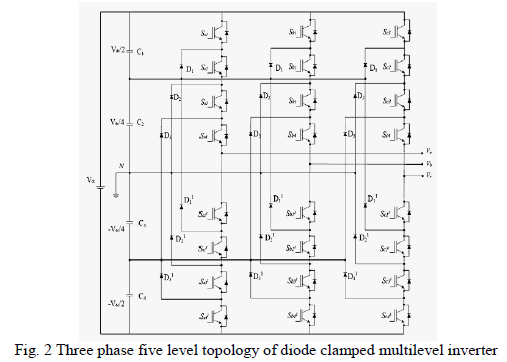 |
| The number of freewheeling diodes (d) per phase, and the number of clamping diodes (j) can be calculated by using Equations (2) and (3) respectively. |
| c = m – 1 (2) |
| d = 2(m − 1) (3) |
| j = (m − 1). (m − 2) (4) |
 |
| The DC-MLI are efficient in fundamental frequency switching applications but the number of clamping diodes required is quadratic ally related to the number of levels. Fundamental frequency switching will cause an increment on voltage and current THD, while increased number of clamping diode makes the topology large. |
SIMULATION AND RESULTS |
| The three phase five level diode clamped multilevel inverter fed BLDC motor speed is controlled by PI controller. Speed is given feedback to PI controller. It compares actual speed and reference speed to produce error signal that is input for PI controller. Back EMF is under process and multiplied with PI output. These are used to give reference signal for sinusoidal PWM. Diode Clamped Multilevel Inverter three phase AC output is connected to BLDC motor terminals. Five level diode clamped multi level inverter for three phases have three legs. For each leg eight switches used (upper leg 4 and lower leg 4 switches). Across the switches freewheeling diodes are connected for protection purpose. Switching pulses are given from the Sinusoidal Pulse Width Modulation Technique. |
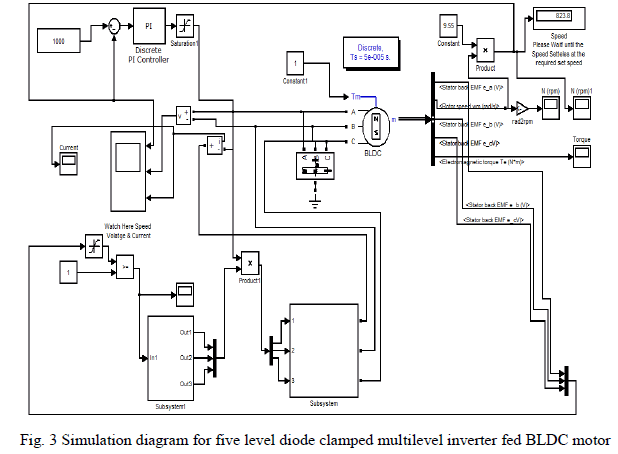 |
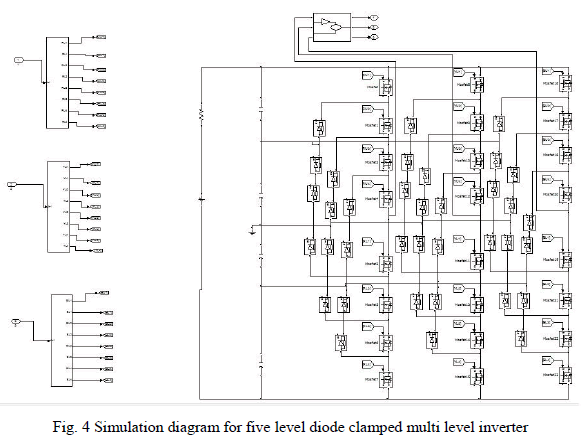 |
| Figure 4 show the simulation diagram of five level diode clamped multilevel inverter . Here subsystem represents the PWM generation circuit, using this circuit reference signal and four sinewave signals with different amplitude are compared. When the reference amplitude is greater than carrier amplitude the gate pulses are produced. Based on this gate pulses five level diode clamped multilevel inverter switches are made ON and OFF. |
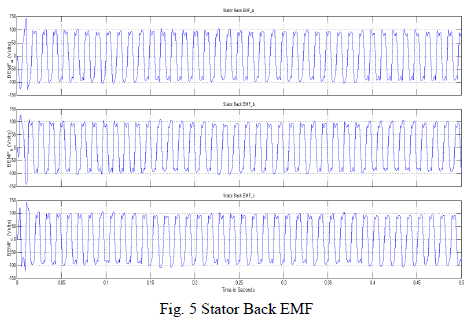 |
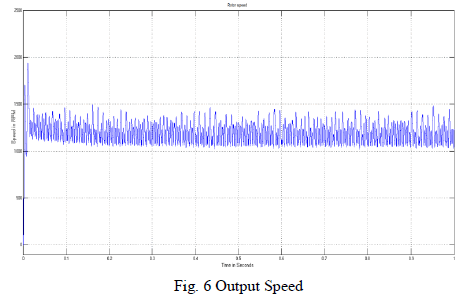 |
| From the above Fig. 6 shows the output speed of three phase five level diode clamped multilevel inverter fed BLDC motor. Output speed can be controlled by PI controller (closed loop control). Speed can change by varying reference speed or set speed. Here the reference speed is 1200rpm and speed vary periodically due to steady state errors in PI controller. |
TORQUE RIPPLE CALCULATION |
| BLDC motor torque pulsations produce noise and vibration in the system. So minimization or elimination of noise and vibration is a considerable problem in BLDC Motor. Two techniques are mainly used to minimize the Torque Pulsations. To improve motor design and motor control schemes. Fig. 7 shows the electromagnetic torque of BLDC motor. Torque ripple is defined as periodic increase and decrease in output torque .The formula for finding the torque ripple the percentage of the difference between the maximum torque (Tmax) and the minimum torque (Tmin) compared to the average torque (Tavg).Percentage Torque ripple can be calculated by the following formula, |
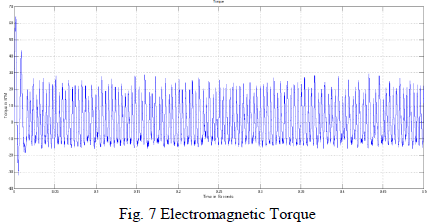 |
| Let us take the above said values from the Fig. 7 for one cycle. The maximum value of torque (Tmax) is 24.4374, minimum value of the torque (Tmin) is 15.8052 and the average value of this torque (Tavg) is 20.12. By substituting the above obtained values in equation (5) we get the torque ripple value is 42.90%. Still further reduction in torque ripple can be achieved by selecting optimum value of PI controller constants. |
CONCLUSION |
| Torque pulsations in BLDC motors brought about by the deviation from ideal conditions are either related to the design factors of the motor or to the power inverter supply, thereby resulting in non ideal current waveforms. Undesirable torque pulsation in the BLDC motor drive causes speed oscillations and excitation of resonances in mechanical portions of the drive, leads the audible noise and visible vibration patterns in high precision machines. In this paper, a five level diode clamped multilevel inverter with PI controller is presented for BLDC. Torque ripples are due to in active phases. The torque ripples have been reduced using diode clamped multilevel inverter with the Sinusoidal Pulse width modulation technique. PI controller is used to control the Speed. The BLDC motor is results are analysed and the amount of torque ripple also calculated. From the simulated results it is evident that the torque ripples are reduced. The main advantage of this method is it uses sensor less technique for the three phases, so it reduces the sensor cost. |
References |
|